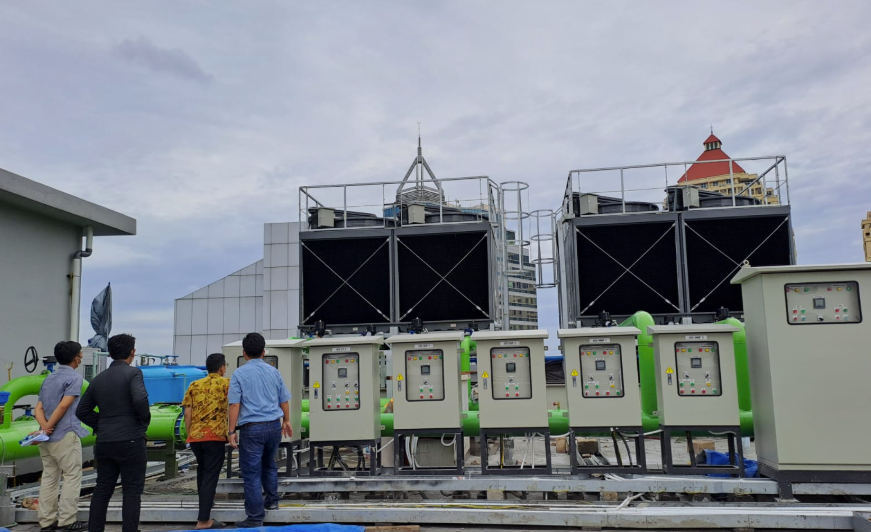The rapid development of Indonesia’s data center industry is driven by hyperscalers, colocation providers, and the ever-growing demand for digital services. However, the traditional Mix & Match approach to power network design falls short in meeting modern requirements for speed, efficiency, and sustainability. A system-level approach—integrating power distribution, cooling, and management systems from a single manufacturer—has emerged as the solution to overcome these challenges. As a Distributor Cooling Data Center, Climanusa introduces this innovative strategy to support Indonesia’s evolving data center landscape.
Challenges in Traditional Data Center Design
The Mix & Match approach to designing power networks often involves assembling components from multiple manufacturers. While historically effective, this method presents several challenges:
- Complex Integration: Compatibility issues between components increase design and operational complexity.
- Higher Costs: Oversizing components to account for mismatches inflates project budgets.
- Operational Risks: Lack of seamless integration leads to inefficiencies, maintenance issues, and longer downtimes.
- Inefficient Cooling: Incompatibility between systems results in underperforming cooling operations, critical for Indonesia’s hot and humid climate.
Benefits of System-Level Design
A system-level approach consolidates power distribution, cooling, and monitoring under a unified architecture, enabling better coordination and efficiency. By leveraging components designed to work together, this method addresses traditional challenges and unlocks new possibilities:
1. Enhanced Component Compatibility
All components, including breakers, UPS units, generators, and transformers, are designed to function seamlessly, eliminating the need for oversized equipment and reducing costs.
2. Efficient Cooling Systems
Integrated cooling technologies, such as direct liquid cooling or modular air handling units, ensure optimal thermal performance even under high-density workloads.
3. Simplified Maintenance
Centralized management systems reduce operator errors, streamline maintenance processes, and enhance uptime reliability.
4. Sustainability
With precise energy monitoring and management, the system-level approach minimizes carbon footprints, aligning with Indonesia’s renewable energy targets.
Real-World Applications for Indonesian Data Centers
Indonesia’s data centers, whether hyperscale or modular, can adopt system-level designs for improved efficiency and scalability:
A. Modular Data Centers
Modular builds are increasingly popular due to their speed of deployment and reduced capital costs. With prefabricated components tested for system-level compatibility, modular data centers can deliver:
- Faster deployment timelines.
- Lower total cost of ownership (TCO).
- Scalability for future expansion.
B. High-Density Computing
Supporting workloads like AI and big data analytics requires advanced cooling solutions and fault-tolerant power systems. A system-level design ensures:
- Enhanced thermal management with liquid cooling.
- Seamless load balancing between power modules.
- Resilience against faults or grid fluctuations.
Steps to Implement a System-Level Design
Climanusa offers end-to-end support in adopting system-level designs:
- Detailed Design Studies: Analyze specific needs for compatibility, load balancing, and cooling requirements.
- Custom Component Selection: Optimize system performance with perfectly matched components.
- Centralized Management Systems: Deploy monitoring tools to provide real-time data and predictive analytics.
- Integrated Testing and Commissioning: Perform factory-level tests to ensure all systems operate cohesively.
Sustainable Innovation with Modular Power Solutions
Innovative technologies system demonstrate the benefits of system-level designs. By combining medium voltage connections, transformers, and low voltage distribution in one compact unit, this solution delivers:
- Cost reductions in cabling and installation.
- Energy savings via low-loss components.
- High safety and compliance with ISO standards.
Conclusion: Pioneering the Future of Data Center Power Design
The system-level approach redefines how power networks and cooling systems are designed, constructed, and managed. By embracing this strategy, Indonesia’s data centers can achieve operational excellence, scalability, and sustainability. As a Distributor Cooling Data Center, Climanusa is dedicated to delivering integrated solutions that meet the needs of today’s fast-evolving digital economy.
Climanusa is your trusted partner for innovative data center solutions, helping to power sustainable and efficient operations in Indonesia.
For more information, please click here.
–A.M.G–

